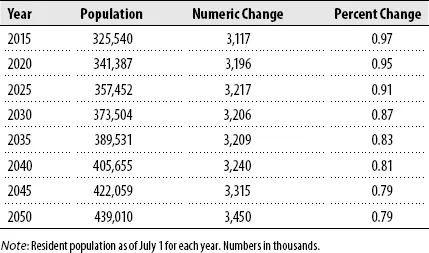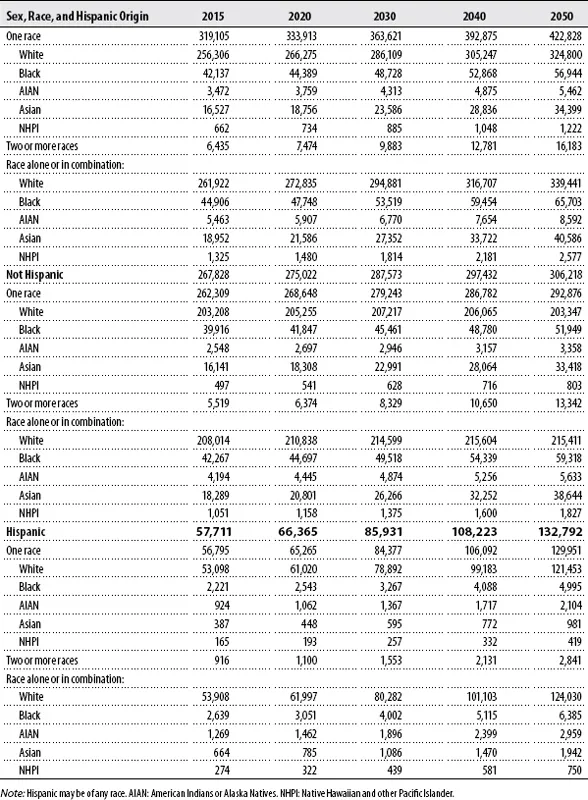![]()
CHAPTER 1
IMPLICATIONS OF CHANGING US DEMOGRAPHICS FOR HEALTH EDUCATORS
Miguel A. Pérez
Raffy R. Luquis
LEARNING OBJECTIVES
After completing this chapter, you will be able to
- Identify the four overarching goals in Healthy People 2020.
- Explain the demographic changes and population trends in the United States.
- Describe selected characteristics of the major racial and ethnic groups in the United States.
- Discuss challenges and opportunities for health educators.
The 1985 Secretary’s Report on Black and Minority Health for the first time authoritatively documented the health disparities that different population groups in the United States experience (US Department of Health and Human Services, 1998). This seminal report provided the basis for the Healthy People initiative, which has established ambitious health benchmarks to be achieved at the end of their respective time frames (US Department of Health and Human Services, 2011).
Healthy People 2020 establishes the current national health targets, with four overarching goals to be achieved by the end of the decade (see box 1.1). Achieving these goals depends on collaboration among sundry segments of society to ensure that Americans not only have access to superior health care services but also incorporate preventive measures, including health education, into their daily lives.
The goals established by Healthy People 2020 require an understanding of demographic shifts and their impact on the health status of selected population segments. This chapter explores the impact of demographic changes on preparing a culturally competent health education workforce. It also provides a brief description of relevant cultural characteristics of each of the major ethnic groups in the United States.
demographic shifts
Statistical changes in the socioeconomic characteristics of a population or consumer group.
BOX 1.1 HEALTHY PEOPLE 2020 OVERARCHING GOALS
- Attain high-quality, longer lives free of preventable disease, disability, injury, and premature death.
- Achieve health equity, eliminate disparities, and improve the health of all groups.
- Create social and physical environments that promote good health for all.
- Promote quality of life, healthy development, and healthy behaviors across all life stages.
Demographic Shifts
Demographic Characteristics
Data from the 2010 decennial census show that 308,745,538 resided in the United States in 2010 (US Census Bureau, 2011a) with steady population increases expected until 2050 (see table 1.1). Moreover, the Census Bureau projects that the nation will become more diverse and the majority of the population will be concentrated in urban areas, continuing a trend that started in the late nineteenth century.
Table 1.1 Projections of the Population and Components of Change for the United States, 2015–2050
Source: US Census Bureau (2008a).
Race and Ethnicity
Census data project a continuing diversification of the US population in terms of race and ethnicity (see table 1.2). In fact, the Agency for Healthcare Research and Quality projects that members of underrepresented groups are expected to make up more than 40 percent of the US population by 2035 and 47 percent by 2050 (Brach & Fraser, 2000). The shifts in the ethnic and racial distribution and the age distribution of the US population denote an urgent need for health educators to develop culturally appropriate programs (Luquis & Pérez, 2005, 2006; Luquis, Pérez, & Young, 2006; Pérez, Gonzalez, & Pinzon-Pérez, 2006).
race
The categorization of parts of a population based on physical appearance due to particular historical social and political forces
ethnicity
Pertaining to or characteristic of a people, especially a group (ethnic group) sharing a common and distinctive culture, religion, language, or the like
Table 1.2 Projections of the Population by Sex, Race, and Hispanic Origin for the United States, 2015–2050 (in thousands)
Source: US Census Bureau (2008b).
The 2000 Census marked a shift in how ethnic and racial data are collected. The Census Bureau introduced a larger pool of options, which allowed individuals to select more than one ethnic or racial background. Although controversial, this measure allows the identification of individuals of mixed descent.
Foreign Born and Immigrant
According to the American Community Survey Five-Year Estimates (2006–2010), 12.7 percent of the US population, or some 38,675,012 people, were foreign born; that is, they were residents who were not US citizens at birth (US Census Bureau, n.d.). This category includes legal permanent residents (immigrants), temporary migrants (such as students), humanitarian migrants (refugees), naturalized US citizens, and persons illegally present in the United States (US Census Bureau, 2006). The remainder of the US population was born in one of the fifty states (85.9 percent) or Puerto Rico (1.3 percent).
The American Community Survey Five-Year Estimates (2006–2010) show that the majority of the foreign-born population, excluding those born at sea, came from Latin America (see table 1.3).
Table 1.3 World Region of Birth of Foreign-Born Population in the United States, 2010
Source: US Census Bureau (n.d.).
| Estimate | Percent |
| Europe | 4,847,078 | 12.5% |
| Asia | 10,747,229 | 27.8 |
| Africa | 1,466,454 | 3.8 |
| Oceania | 214,809 | 0.6 |
| Latin America | 20,565,108 | 53.2 |
| North America | 834,095 | 2.2 |
Approximately 72 percent of foreign-born individuals are legal immigrants, with over a third (37 percent) being naturalized citizens. It is estimated that some 8 million foreign-born individuals were unauthorized immigrants in 2010, marking a decrease from a peak of 8.4 million in 2007 (Hoefer, Rytina, & Baker, 2011; Passel & Cohn, 2011).
Language
Almost 80 percent of the US population 5 years and older speaks only English (US Census, n.d.). Of those who speak a language other than English at home, 8.7 percent report speaking it “less than well.” (See table 1.4 for a list of the major languages spoken in the United States.)
Table 1.4 Languages Spoken in the United States, 2010
Source: US Census Bureau (n.d.).
| Language | Percent |
| English | 79.9% |
| Spanish | 12.5 |
| Other Indo-European | 3.7 |
| Asian and Pacific Islander | 3.1 |
| Other | 0.8 |
California has the largest percentage of residents who speak a language at home other than English (40.8 percent), followed by New Mexico (36.0 percent) and Texas (32.5 percent) (US Census Bureau, n.d.).
The Elderly
The median age in the United States in 2010 was 37 years of age; however, the fastest-growing age group is those age 65 and older (table 1.5). In fact, demographers estimate that the number of individuals in this age category will more than double by the middle of this century (US Census Bureau, 1995, 2010b). (See table 1.5 for age distribution in the United States in 2010.)
Table 1.5 Projections of the Population by Selected Age Groups for the United States, 2015–2050
Source: US Census Bureau (2010b).
The elderly population is characterized by several factors, including more females than males (57 percent and 43 percent, respectively, in 2010). Not surprisingly, as the population shifts, the elderly population is also expected to become more racially and ethnically diverse. The proportion of elderly in each of the four major racial and ethnic groups—white, black, American Indian and Alaska Native, and Asian and Pacific Islander and in the Hispanic-origin population—is expected to increase substantially during the first half of this century.
Gender
In 2010, 50.8 percent of the US population were females and 49.2 percent were males. Similarly, in 2010, 85.9 percent of females and 84.6 percent of males had obtained a high school diploma, and 27.5 percent of females and 28.5 percent of males had obtained a baccalaureate degree (US Census, 2010b).
Sexual Orientation
...


